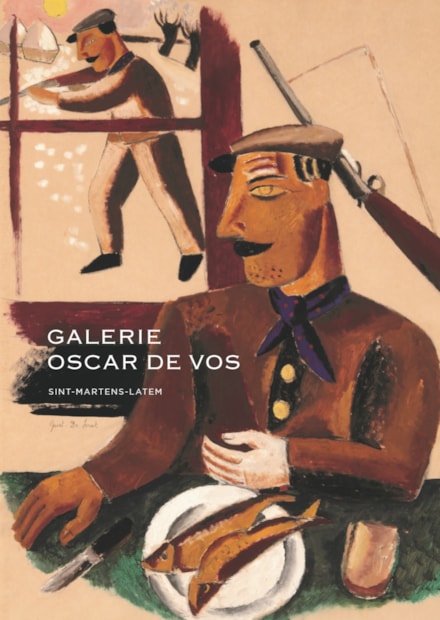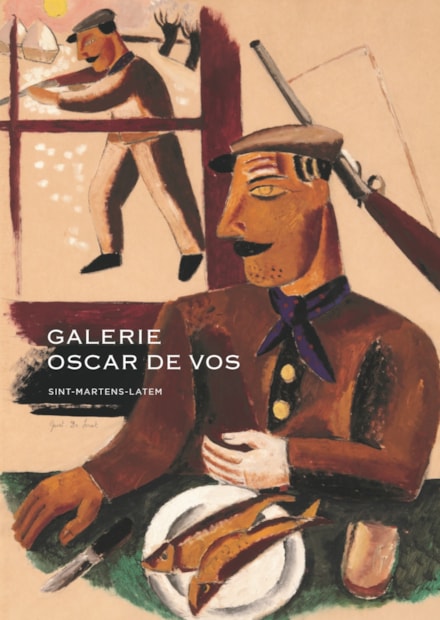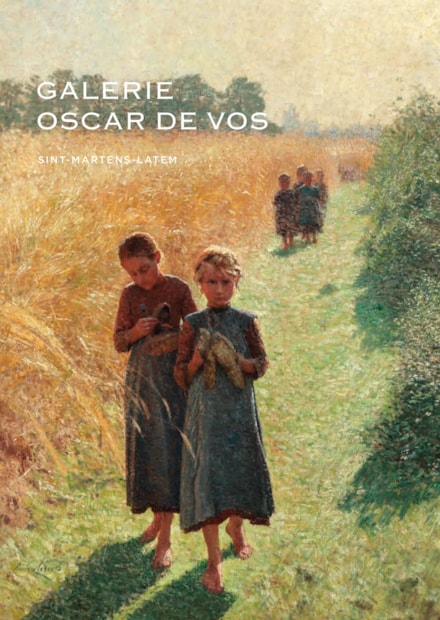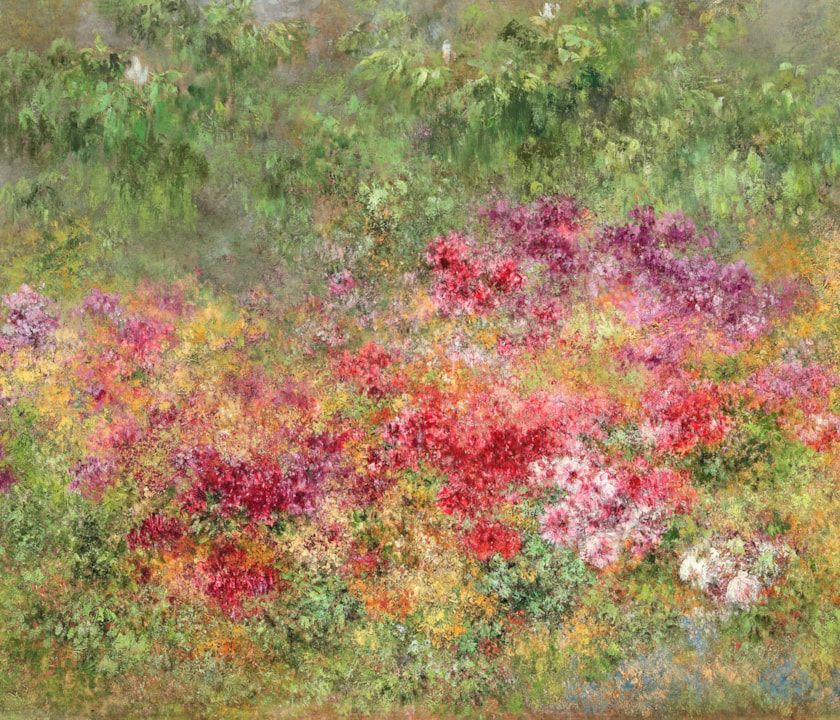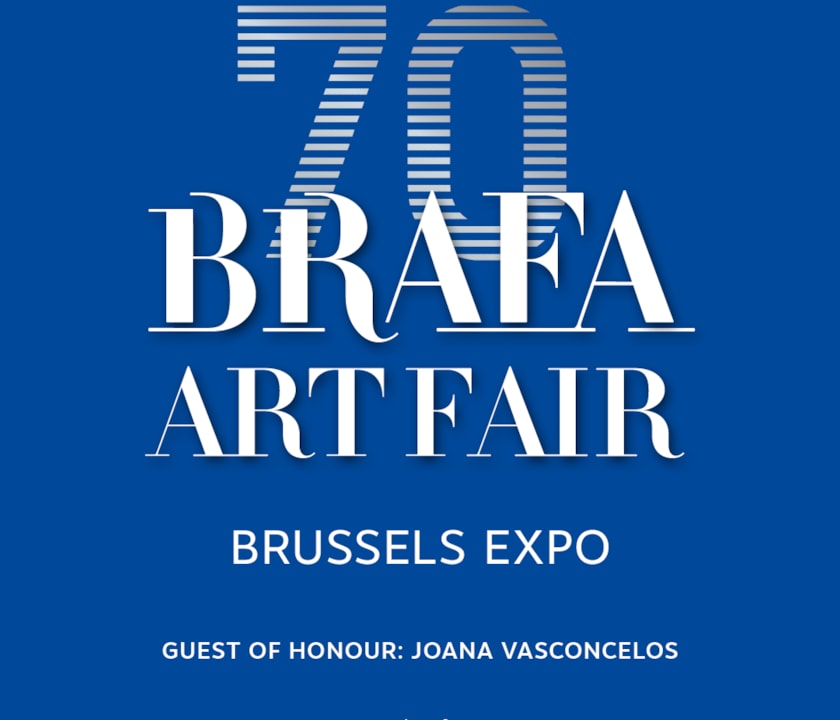Frits Van den Berghe
(1883 - 1939)
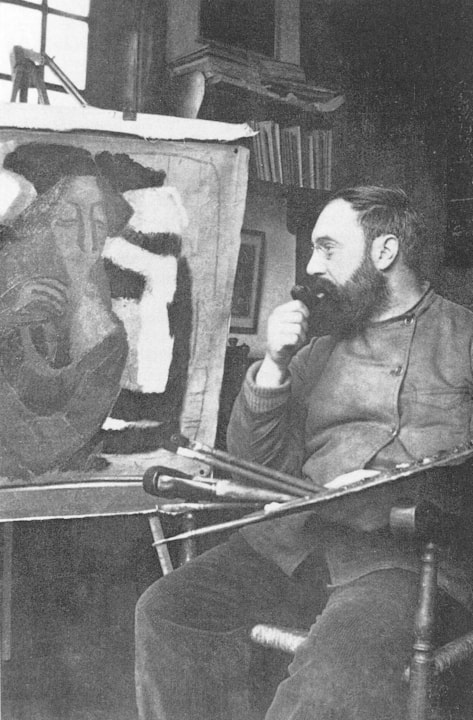
Frits Van den Berghe
(1883 - 1939)
Frits Van den Berghe naît le 3 avril 1883 à Gand. À cette époque, son père Raphaël est secrétaire de la Bibliothèque de l’Université de Gand, et son érudition est célèbre dans tout le corps professoral. À partir de 1898, le jeune Frits se forme à l’Académie des Beaux-Arts de Gand. Parmi ses condisciples, il compte, entre autres, Leon De Smet et Albert Servaes avec qui il s’installe en 1902 dans un atelier de la Rasphuisstraat. Mais, pendant cette même année, il part avec son ami intime Robert Aerens à Laethem-Saint-Martin. On le retrouve de nouveau avec Servaes en 1904 à Laethem. Dès 1908, il établit son domicile dans le village; il passe les hivers à Gand. La même année, il est nommé professeur à l’académie. Entre-temps, il a rencontré à Laethem Paul-Gustave et André De Ridder, qui seront toute sa vie ses amis.
Peu avant la Première Guerre Mondiale, Van den Berghe traverse une crise grave. Avec une amie, il part aux États-Unis, mais il revient désappointé après quelques mois. Peu après, la guerre éclate et, avec Gustave De Smet, il s’enfuit aux Pays-Bas. Dans un premier temps, le peintre néerlandais Leo Gestel s’occupe de ses compères belges; André De Ridder emboîte lui aussi le pas de ses amis. Et tant De Smet que Van den Berghe sont rapidement remarqués dans le milieu artistique amstellodamois. En 1915 déjà, le “Larensche Kunsthandel” montre de l’intérêt pour leur travail. En 1916 suit la première grande exposition de leur travail sur une terre étrangère. À l’instigation de De Ridder, la galerie Heystee, Smith & Co propose une vaste exposition de leur œuvre. Amsterdam ne peut cependant pas leur suffire, et en août déjà ils partent à Blaricum. La même année encore, Van den Berghe est l’hôte remarqué d’une exposition des exilés belges au Stedelijk Museum. Ces exilés belges se regroupent par la suite dans le Gooi, et forment en compagnie de De Smet et Jozef Cantré une colonie d’exilés dénommée ‘Klein Gent” (Petite Gand).
Bien qu’il ne soit revenu en Belgique qu’en 1922, Van den Berghe joue un rôle déterminant dans la création de la galerie Sélection. Depuis la naissance du mouvement, en 1921, l’artiste est sous contrat avec la galerie; plus tard, Walter Schwarzenberg le lie contractuellement à la galerie Le Centaure.
Après un court séjour chez Permeke à Ostende, Van den Berghe part à l’été 1922 à Bachte-Maria-Leerne. Un an plus tard, on le retrouve avec De Smet à la Villa Malpertuis de Paul-Gustave Van Hecke, où il retourne régulièrement les années suivantes. Le Centaure l’honore en janvier 1927 d’une exposition individuelle dans sa galerie. En avril de la même année, il en est de nouveau l’invité. Van Hecke continue à soutenir son poulain avec, entre autres, une exposition individuelle dans sa Galerie L’Époque en novembre 1928. En mars 1931 encore, Le Centaure réalise une exposition individuelle de son travail; dans le courant de cette année, Sélection consacre tout un numéro thématique à l’artiste.
Lorsque ses principaux commanditaires font faillite en 1931-1932, dix ans d’histoire sont éparpillés en quelques mois. Les collections de De Ridder, Van Hecke et Schwarzenberg et celles de leurs galeries sont vendues aux enchères et sans limite plancher. Avec De Smet et Hubert Malfait, Van den Berghe fait partie des plus gravement touchés. Pas moins de cent et six œuvres majeures de l’artiste sont mises à l’encan pour des croûtes de pain.
Il faut dire que la presse conservatrice s’empare de la crise économique et de la faillite des galeries modernistes pour annoncer également la fin de l’expressionnisme, le courant dominant dans les années 1920. En conséquence, les modernistes de 1920, De Smet et Van den Berghe en tête, sont subitement placés sous un piètre éclairage. Ajoutons à cela que Van den Berghe se retire d’un milieu artistique versatile. Pour assurer le pain quotidien, Van Hecke le présente à l’éditeur socialiste “Het Licht te Gent” chez qui il travaille comme illustrateur. Plein d’enthousiasme, Van den Berghe se consacre les années suivantes à cette mission. Ses illustrations paraissent dans le quotidien Vooruit; il porte également dans les hebdomadaires ‘Koekoek’ et ‘Voor Allen’ son regard humoristique et parfois satyrique sur les sommités culturelles et politiques de ce temps.
Dans les années 1930, Van den Berghe n’apparaît plus que rarement à l’avant-scène. En 1933, le “Gentse Socialistische Studiekring” (Cercle d’Études Socialistes Gantois) organise une exposition double avec Jozef Cantré; la même année, Emile Langui publie la première monographie consacrée à l’artiste. Alice Manteau organise en 1936 une petite exposition de son travail.
En septembre 1939, se profile quand même la reconnaissance officielle de son œuvre, lorsqu’il est porté à la direction de l’académie de Gand. Le décès inopiné de Van den Berghe le 23 septembre de cette même année rend cette reconnaissance impossible.
Peu avant la Première Guerre Mondiale, Van den Berghe traverse une crise grave. Avec une amie, il part aux États-Unis, mais il revient désappointé après quelques mois. Peu après, la guerre éclate et, avec Gustave De Smet, il s’enfuit aux Pays-Bas. Dans un premier temps, le peintre néerlandais Leo Gestel s’occupe de ses compères belges; André De Ridder emboîte lui aussi le pas de ses amis. Et tant De Smet que Van den Berghe sont rapidement remarqués dans le milieu artistique amstellodamois. En 1915 déjà, le “Larensche Kunsthandel” montre de l’intérêt pour leur travail. En 1916 suit la première grande exposition de leur travail sur une terre étrangère. À l’instigation de De Ridder, la galerie Heystee, Smith & Co propose une vaste exposition de leur œuvre. Amsterdam ne peut cependant pas leur suffire, et en août déjà ils partent à Blaricum. La même année encore, Van den Berghe est l’hôte remarqué d’une exposition des exilés belges au Stedelijk Museum. Ces exilés belges se regroupent par la suite dans le Gooi, et forment en compagnie de De Smet et Jozef Cantré une colonie d’exilés dénommée ‘Klein Gent” (Petite Gand).
Bien qu’il ne soit revenu en Belgique qu’en 1922, Van den Berghe joue un rôle déterminant dans la création de la galerie Sélection. Depuis la naissance du mouvement, en 1921, l’artiste est sous contrat avec la galerie; plus tard, Walter Schwarzenberg le lie contractuellement à la galerie Le Centaure.
Après un court séjour chez Permeke à Ostende, Van den Berghe part à l’été 1922 à Bachte-Maria-Leerne. Un an plus tard, on le retrouve avec De Smet à la Villa Malpertuis de Paul-Gustave Van Hecke, où il retourne régulièrement les années suivantes. Le Centaure l’honore en janvier 1927 d’une exposition individuelle dans sa galerie. En avril de la même année, il en est de nouveau l’invité. Van Hecke continue à soutenir son poulain avec, entre autres, une exposition individuelle dans sa Galerie L’Époque en novembre 1928. En mars 1931 encore, Le Centaure réalise une exposition individuelle de son travail; dans le courant de cette année, Sélection consacre tout un numéro thématique à l’artiste.
Lorsque ses principaux commanditaires font faillite en 1931-1932, dix ans d’histoire sont éparpillés en quelques mois. Les collections de De Ridder, Van Hecke et Schwarzenberg et celles de leurs galeries sont vendues aux enchères et sans limite plancher. Avec De Smet et Hubert Malfait, Van den Berghe fait partie des plus gravement touchés. Pas moins de cent et six œuvres majeures de l’artiste sont mises à l’encan pour des croûtes de pain.
Il faut dire que la presse conservatrice s’empare de la crise économique et de la faillite des galeries modernistes pour annoncer également la fin de l’expressionnisme, le courant dominant dans les années 1920. En conséquence, les modernistes de 1920, De Smet et Van den Berghe en tête, sont subitement placés sous un piètre éclairage. Ajoutons à cela que Van den Berghe se retire d’un milieu artistique versatile. Pour assurer le pain quotidien, Van Hecke le présente à l’éditeur socialiste “Het Licht te Gent” chez qui il travaille comme illustrateur. Plein d’enthousiasme, Van den Berghe se consacre les années suivantes à cette mission. Ses illustrations paraissent dans le quotidien Vooruit; il porte également dans les hebdomadaires ‘Koekoek’ et ‘Voor Allen’ son regard humoristique et parfois satyrique sur les sommités culturelles et politiques de ce temps.
Dans les années 1930, Van den Berghe n’apparaît plus que rarement à l’avant-scène. En 1933, le “Gentse Socialistische Studiekring” (Cercle d’Études Socialistes Gantois) organise une exposition double avec Jozef Cantré; la même année, Emile Langui publie la première monographie consacrée à l’artiste. Alice Manteau organise en 1936 une petite exposition de son travail.
En septembre 1939, se profile quand même la reconnaissance officielle de son œuvre, lorsqu’il est porté à la direction de l’académie de Gand. Le décès inopiné de Van den Berghe le 23 septembre de cette même année rend cette reconnaissance impossible.
oeuvres
publications









